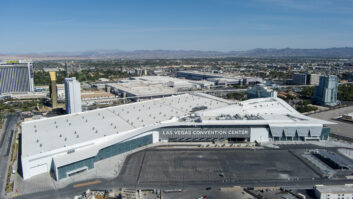It is likely that few broadcast engineers pursued their dream jobs based on their enthusiasm for a specific radio station. Yet that is the case with Nandini Sen, who this year was promoted to the job of director of technologies and engineering at North Carolina Public Radio WUNC(FM), owned by the University of North Carolina.
“In 2001 I was looking for a job in IT in Chapel Hill when I heard about an opening here,” she said. “I always loved this station and listened to it all the time. They had two engineers who were doing everything from transmitter maintenance to production to tech support, but they were expanding and changing formats. I thought it would be great to work here so I applied.”
But even though she loved the sound of the station, she was less impressed by the physical plant.
“I did not know ‘engineering’ at the time; all I saw were wires and cables strung everywhere. The back of the equipment racks in both the technical center and the studios was scary.
“I had never seen so many wires, literally thousands of them,” she continued. “They were just everywhere and I kept thinking I couldn’t handle the job. How would I trace down problems? It was a huge, messy technical center with ancient servers and computers.”
Fortunately, while Sen came from a pure IT background, she’d always liked to tinker.
“When I was growing up I would take all my toys apart and put them back together,” she said. “My watch, my CD player, whatever I had.
‘How to Provide It in Real Time’Nandini Sen’s responsibilities encompass production engineering, including oversight of the station’s audio engineers; operations, including continuity, automation scheduling, automation and downloads from ContentDepot; scheduling underwriting; IT systems and management; and five transmitters in central North Carolina and east to the Outer Banks, including the main site near Chapel Hill and four repeaters.
The Chapel Hill and Durham studio locations are about nine miles apart, and the main RF plant is about the same distance from Chapel Hill. A DS3 on fiber connects Chapel Hill and Durham over a Broadcast Electronics Big Pipe codec carrying 16 channels of audio, bidirectional video, four RS-232 serial data channels, variable bandwidth private Ethernet for the station’s Wheatstone network and a E1/T1 with eight channels of dial tone. A 50 MB Layer 3, point-to-point, switched Ethernet system extends the campus network to the Durham studios.
In addition to a satellite downlink, WUNC also has a licensed uplink, a SCPC 300 kb bandwidth channel; it also has a 3 MB Ethernet point-to-point connection to the NPR network operations center.
Between Chapel Hill and the WUNC RF plant are two traditional 950 MHz digital microwave links.
WUNC and translator WRQM(FM) are broadcasting in HD Radio, though the organization has not implemented multicasting. Translator WUND(FM) is analog but is a solid-state transmitter that could be upgraded to HD. “On WURI and WBUX, we broadcast classical music in partnership with WCPE,” the classical station in Wake Forest, she said.
WUNC’s operation also includes podcasting and three Web streams, plus special streams of various events around the state.
As to her IT and studio infrastructure and policies, “We use an EMC2 Storage Area Network at both locations mirroring each other. We have always been primarily a Novell shop,” she continued. “Before we built Durham, I wish we had converted to Windows and take advantage of clustering. That would have been ideal.
(click thumbnail)Changing a hard drive on an user computer. Keith Weston, WUNC
“We use ENCO and Adobe Audition primarily for audio production. On the customer relationship management and fundraiser side, we use Enterprise Access International, Blackbaud and Act!, and Marketron DeltaFlex for traffic, and we are getting ready to upgrade in early 2009. We are pretty lenient on use of browsers, etc., within reason.”
Radio World asked Sen to name the most important decision she had to make in overseeing expansion of WUNC’s network infrastructure and storage systems.
“Connectivity,” she replied. “How to provide that in real time. Playing something out of one location and accessing the on-air material from more than one location without a lag. We solved the latency issues.
“I have a special interest in making it easy for our reporters and producers to work from anywhere in the city, the state or wherever — making the world smaller for them in terms of connectivity back to the mother ship, accessibility of information.”“But when I considered the job at WUNC, the draw really wasn’t the engineering side of it; it was the on-air product, which was news and classical music at that time. I wanted to be a part of that product. The place was not behind the times in terms of its programming, but they did not have IT people on staff.
“The old equipment definitely made me think twice. In fact, several times.”
Wright start
However, she took the job. That same year the station dropped music and added talk programming, much of which is locally originated.
Sen helped rebuild its technical center in Chapel Hill — “My first project was to upgrade the server, purchase new hardware, install newest version of the NOS and provide technical support to the staff” — and five years later she helped design and construct additional studios in nearby Durham. The man who hired her, David Wright, guided her and became a mentor.
“It keeps me excited to take on projects that are way beyond my technological knowledge, and David was a big help,” she said. “I just want to continue to benefit from his knowledge. I would be remiss if I did not also mention John Francioni. With their collective knowledge and experience of over 60 years, I will never run out of things to learn.” The station does not use the title “chief engineer,” but Wright is WUNC’s site engineer at the Durham location and Francioni is site engineer for Chapel Hill.
Sen considers the design and construction of the Durham studios a highlight in her career.
“Before we started, we visited some other facilities around the country to see what they were building,” she said. “When we got back, I became involved with furniture design, equipment purchases, ADA compliance, acoustics and even the colors of the walls. We built five studios and two control rooms in Durham and we still have two control rooms and five studios here in Chapel Hill.”
Why build a second studio not far away in Durham when North Carolina Public Radio owned a facility in Chapel Hill?
“We had outgrown our place here, and we received the Durham space as a gift from Jim Goodman of Capitol Broadcasting,” she said. “Even though he is involved with commercial radio, he is a champion of public broadcasting. The Durham location was also a way we could be more visible and be part of our community.”
From IT to engineering
Sen has seven full-time and several part-time employees reporting to her; she in turn reports to the general manager, a position that is vacant at this writing. Prior to her promotion she had been the director of IT and operations.
“I’ve only recently taken over engineering here and gotten involved with the RF side,” she said. “My largest challenge is to expand my knowledge.
“I am in my element when I am in the technical center, or in my office, tinkering with things. Yes, I am a typical introvert engineer. But I try to get out of my comfort zone and meet with listeners, volunteers and donors. Their passion for public radio always surprises, energizes and enthuses me.”
During her first weeks at the station, Sen was out of her comfort zone often and in fact, accidentally took the station off the air.
“I was petrified but it was a simple mistake,” she said. “We were only off for a minute. I was supposed to reboot the applications servers. Instead I turned off the on-air server. Neither server was labeled.”
Nandini Sen is a testimony to ongoing learning. She has received several degrees and honors in her native India as well as in the United States.
She studied English literature at the University of Kolkata; computer and Web programming at UCLA and California State University, Fullerton; computer networking and database administration at Alamance Community College; and Internet technologies at Durham Technical College.
She also has participated in certificate programs in project management, management and communication at the University of North Carolina Chapel Hill; and she held a National Association of Broadcasters Education Foundation Connection Mentorship with Don Lockett of the Corporation for Public Broadcasting.
The biggest challenge Sen sees for the radio industry is finding more young people to enter engineering.
“There are a lot of people interested in the shiny side of broadcasting, the new media, but we need people who can open a box and fix what is inside a few minutes before going on the air.”
Sen, 36, is a big believer in diversity as well as youth. “We have to make radio engineering attractive to women and minorities,” she said. “I feel very lonely when I go to conferences.
“I remember when I started out, I would go to the NAB/Public Radio Engineering Conferences and there were no women but me! I commented on that this year at the PREC. Now there are a few other women and minorities who come to these things, but we need to find these people and teach them what we know.”
Robert Levin is deputy director/CEO at North Carolina Public Radio; he is a supporter.
“The past seven years she has overseen the expansion of WUNC’s network infrastructure and storage systems,” he said. “She’s hard-working and exemplifies the team spirit at North Carolina Public Radio. Nandini is courageous in taking on monumental new tasks.”
Passion
What do Sen and her engineering/IT colleagues discuss when they get together?
“There is so much to think and talk about, so much pull in so many different directions,” she said. “An immense amount of new exciting stuff is going on in the industry, and we are trying to keep up with all of that, even at a very shallow level.
“I think what social media is doing for the broadcasting industry is amazing. Broadcasting in itself does not mean the same thing today as it did even when I started.”
A big challenge today, she feels, is the lack of interest and information in and about broadcasting among IT engineers. “Broadcasting engineering is converging. We need people who understand both sides.”
Sen is single and plans to start a family soon.
“I have devoted much time to my career,” she said. “But I have really found my calling, which is the expansion of the public’s intellect through public radio. It is about engaging them, informing them and enhancing their quality of life through it. I like the technical side, but being able to work for a cause I believe in has been great. I have found my passion here.”













